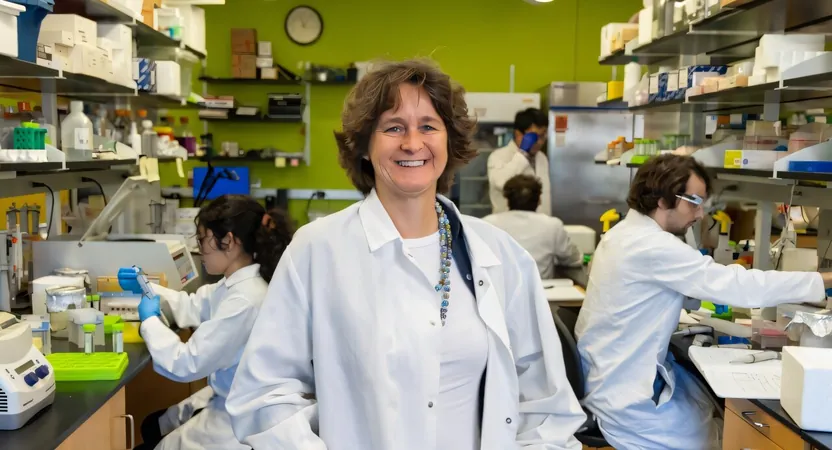
Breakthrough Discovery: RNA's Surprising Role in DNA Damage Repair Could Revolutionize Medical Treatments!
2024-11-21
Author: Jia
Groundbreaking Study Unveils RNA's Role in DNA Repair
In a groundbreaking study led by Francesca Storici from Georgia Tech, a multi-institutional team of researchers has unveiled a crucial and previously unrecognized role for RNA in the repair of DNA damage. This discovery not only reshapes our understanding of genetic health and evolution but also opens exciting avenues for improved treatments of diseases such as cancer and neurodegenerative disorders.
Traditional Understanding of RNA
Traditionally, RNA has been known primarily as a messenger that transports genetic instructions from DNA to ribosomes, the cellular factories responsible for protein synthesis. However, the innovative research from Storici's team demonstrates that RNA is not just a messenger; it actively participates in repairing one of the most severe forms of DNA damage: double-strand breaks (DSBs).
Significance of Double-Strand Breaks
A double-strand break occurs when both strands of the DNA helix are severed—a potentially catastrophic event for cellular integrity. If not repaired correctly, DSBs can lead to mutations, cell death, or even the development of cancer. Intriguingly, standard cancer treatments, including chemotherapy and radiation, can themselves induce such damage.
Findings of the Research Team
Over a decade ago, Storici and her collaborators first suggested that RNA could serve as a template for repairing these dangerous DSBs. Their latest findings, detailed in the journal Nature Communications, extend this idea significantly, revealing that RNA might directly enhance the mechanisms responsible for DSB repair.
Mathematical Techniques in Research
The researchers employed advanced mathematical techniques to visualize millions of repair events, uncovering stark differences in how repairs happen based on the location of the DSB. This innovative approach highlighted varying repair efficiencies, emphasizing RNA's influential role in determining the repair success.
RNA's Role in DNA Repair Process
As Storici explained, 'RNA can help keep the broken DNA ends aligned, acting like a foreman on a construction site to ensure repairs are performed accurately.' Using both human and yeast cells in their experiments, the team discovered that RNA could literally lock into place at the site of a DSB, providing a scaffold that guides the essential cellular machinery to perform repairs.
Broader Implications of RNA Research
This function suggests that RNA not only serves as a messenger but also plays the dual role of both foreman and laborer in the complex process of DNA repair. The implications of this discovery are profound, indicating that strengthening RNA's role in repair processes could lead to new strategies for enhancing the resilience of healthy cells and minimizing the adverse effects of chemotherapy and radiation therapies.
Future of RNA in Healthcare
Storici concluded, 'RNA has a much broader function than we previously understood. There is still a great deal of research to be done, but our findings open exciting new possibilities for how we might leverage RNA in healthcare, potentially paving the way to novel treatments for cancer and other genetic disorders.'
Conclusion and Future Directions
As the research team delves deeper into RNA's multifaceted contributions to DNA repair, their groundbreaking work could leave an indelible mark on human health and evolutionary biology. This could lead to transformative gene therapies, innovative cancer treatments, and strategies for combating aging, as well as providing insights into the adaptability and evolution of living organisms.
Stay tuned—this remarkable discovery could change the way we approach diseases and gene therapy forever!


 Brasil (PT)
Brasil (PT)
 Canada (EN)
Canada (EN)
 Chile (ES)
Chile (ES)
 España (ES)
España (ES)
 France (FR)
France (FR)
 Hong Kong (EN)
Hong Kong (EN)
 Italia (IT)
Italia (IT)
 日本 (JA)
日本 (JA)
 Magyarország (HU)
Magyarország (HU)
 Norge (NO)
Norge (NO)
 Polska (PL)
Polska (PL)
 Schweiz (DE)
Schweiz (DE)
 Singapore (EN)
Singapore (EN)
 Sverige (SV)
Sverige (SV)
 Suomi (FI)
Suomi (FI)
 Türkiye (TR)
Türkiye (TR)